FORD MUSTANG 2008 5.G Shelby GT500 Supplement Manual
Manufacturer: FORD, Model Year: 2008, Model line: MUSTANG, Model: FORD MUSTANG 2008 5.GPages: 40, PDF Size: 0.32 MB
Page 11 of 40
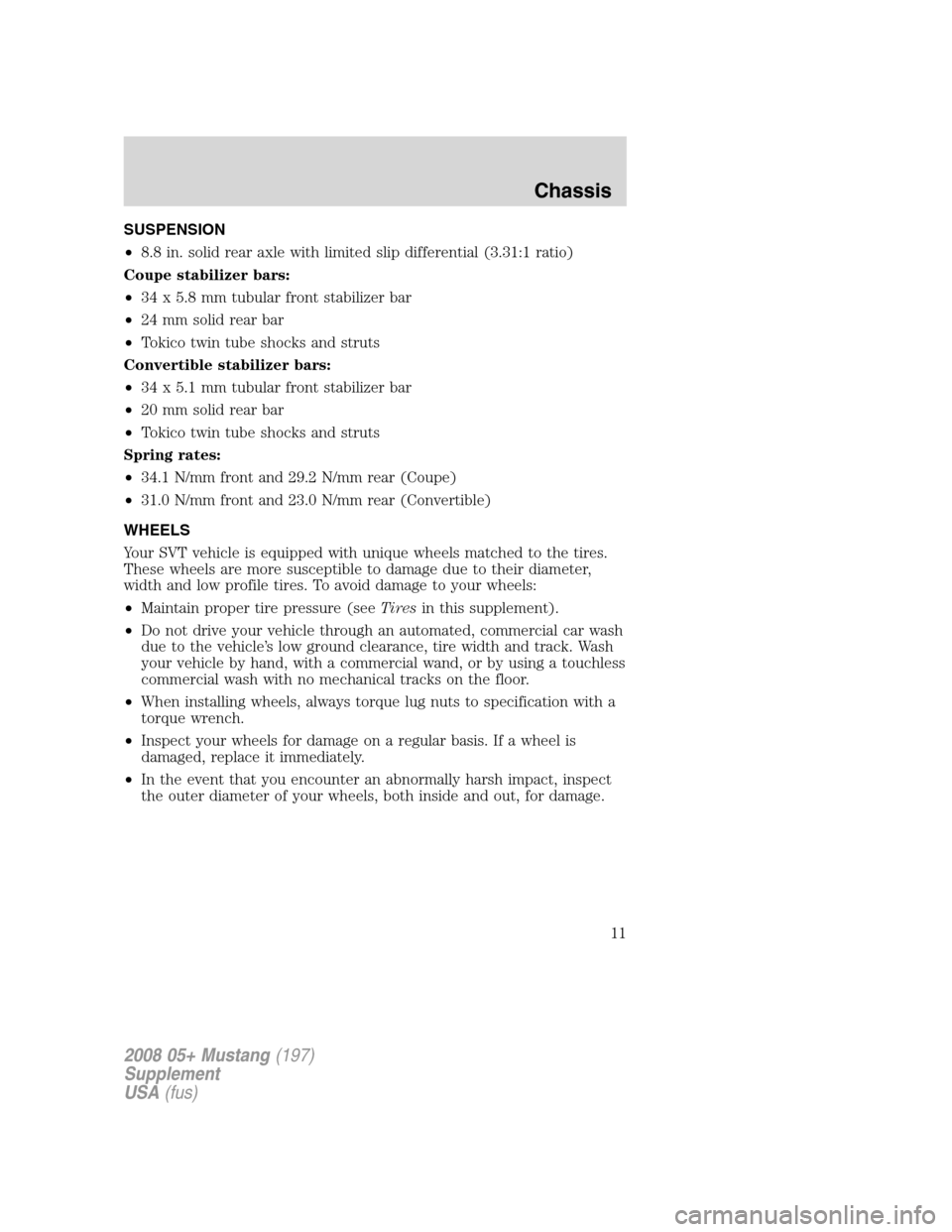
SUSPENSION
•8.8 in. solid rear axle with limited slip differential (3.31:1 ratio)
Coupe stabilizer bars:
•34 x 5.8 mm tubular front stabilizer bar
•24 mm solid rear bar
•Tokico twin tube shocks and struts
Convertible stabilizer bars:
•34 x 5.1 mm tubular front stabilizer bar
•20 mm solid rear bar
•Tokico twin tube shocks and struts
Spring rates:
•34.1 N/mm front and 29.2 N/mm rear (Coupe)
•31.0 N/mm front and 23.0 N/mm rear (Convertible)
WHEELS
Your SVT vehicle is equipped with unique wheels matched to the tires.
These wheels are more susceptible to damage due to their diameter,
width and low profile tires. To avoid damage to your wheels:
•Maintain proper tire pressure (seeTiresin this supplement).
•Do not drive your vehicle through an automated, commercial car wash
due to the vehicle’s low ground clearance, tire width and track. Wash
your vehicle by hand, with a commercial wand, or by using a touchless
commercial wash with no mechanical tracks on the floor.
•When installing wheels, always torque lug nuts to specification with a
torque wrench.
•Inspect your wheels for damage on a regular basis. If a wheel is
damaged, replace it immediately.
•In the event that you encounter an abnormally harsh impact, inspect
the outer diameter of your wheels, both inside and out, for damage.
2008 05+ Mustang(197)
Supplement
USA(fus)
Chassis
11
Page 12 of 40
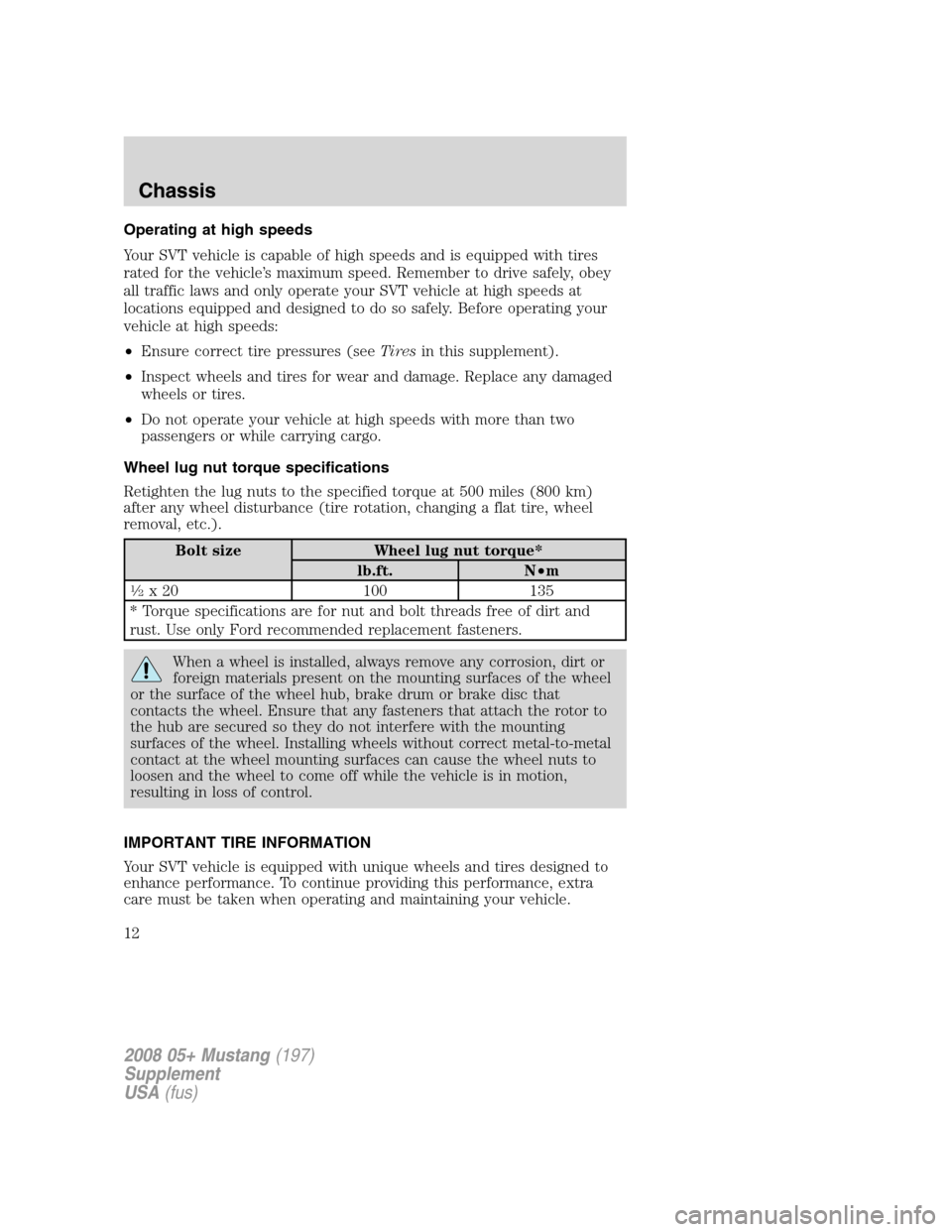
Operating at high speeds
Your SVT vehicle is capable of high speeds and is equipped with tires
rated for the vehicle’s maximum speed. Remember to drive safely, obey
all traffic laws and only operate your SVT vehicle at high speeds at
locations equipped and designed to do so safely. Before operating your
vehicle at high speeds:
•Ensure correct tire pressures (seeTiresin this supplement).
•Inspect wheels and tires for wear and damage. Replace any damaged
wheels or tires.
•Do not operate your vehicle at high speeds with more than two
passengers or while carrying cargo.
Wheel lug nut torque specifications
Retighten the lug nuts to the specified torque at 500 miles (800 km)
after any wheel disturbance (tire rotation, changing a flat tire, wheel
removal, etc.).
Bolt size Wheel lug nut torque*
lb.ft. N•m
1�2x 20 100 135
* Torque specifications are for nut and bolt threads free of dirt and
rust. Use only Ford recommended replacement fasteners.
When a wheel is installed, always remove any corrosion, dirt or
foreign materials present on the mounting surfaces of the wheel
or the surface of the wheel hub, brake drum or brake disc that
contacts the wheel. Ensure that any fasteners that attach the rotor to
the hub are secured so they do not interfere with the mounting
surfaces of the wheel. Installing wheels without correct metal-to-metal
contact at the wheel mounting surfaces can cause the wheel nuts to
loosen and the wheel to come off while the vehicle is in motion,
resulting in loss of control.
IMPORTANT TIRE INFORMATION
Your SVT vehicle is equipped with unique wheels and tires designed to
enhance performance. To continue providing this performance, extra
care must be taken when operating and maintaining your vehicle.
2008 05+ Mustang(197)
Supplement
USA(fus)
Chassis
12
Page 13 of 40
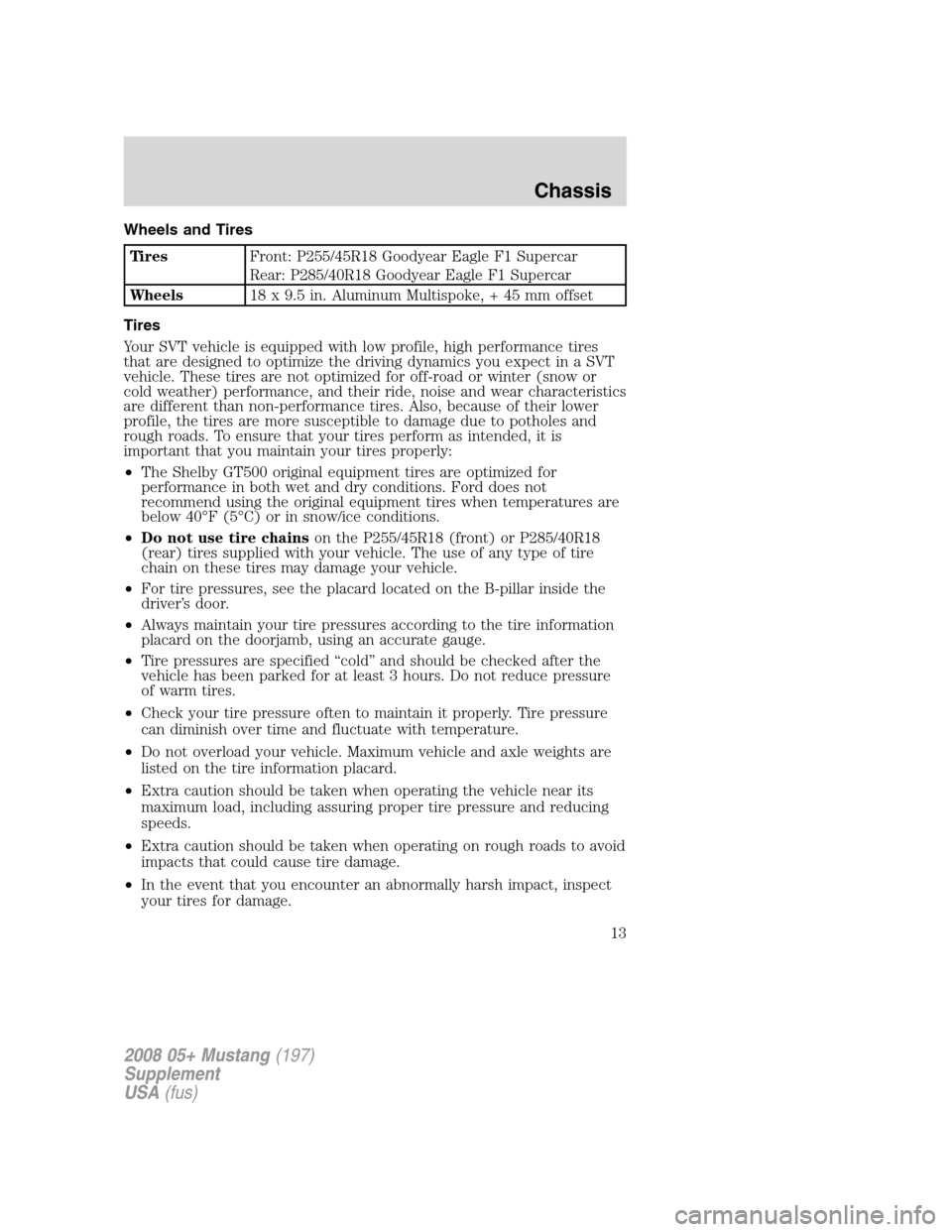
Wheels and Tires
TiresFront: P255/45R18 Goodyear Eagle F1 Supercar
Rear: P285/40R18 Goodyear Eagle F1 Supercar
Wheels18 x 9.5 in. Aluminum Multispoke, + 45 mm offset
Tires
Your SVT vehicle is equipped with low profile, high performance tires
that are designed to optimize the driving dynamics you expect in a SVT
vehicle. These tires are not optimized for off-road or winter (snow or
cold weather) performance, and their ride, noise and wear characteristics
are different than non-performance tires. Also, because of their lower
profile, the tires are more susceptible to damage due to potholes and
rough roads. To ensure that your tires perform as intended, it is
important that you maintain your tires properly:
•The Shelby GT500 original equipment tires are optimized for
performance in both wet and dry conditions. Ford does not
recommend using the original equipment tires when temperatures are
below 40°F (5°C) or in snow/ice conditions.
•Do not use tire chainson the P255/45R18 (front) or P285/40R18
(rear) tires supplied with your vehicle. The use of any type of tire
chain on these tires may damage your vehicle.
•For tire pressures, see the placard located on the B-pillar inside the
driver’s door.
•Always maintain your tire pressures according to the tire information
placard on the doorjamb, using an accurate gauge.
•Tire pressures are specified “cold” and should be checked after the
vehicle has been parked for at least 3 hours. Do not reduce pressure
of warm tires.
•Check your tire pressure often to maintain it properly. Tire pressure
can diminish over time and fluctuate with temperature.
•Do not overload your vehicle. Maximum vehicle and axle weights are
listed on the tire information placard.
•Extra caution should be taken when operating the vehicle near its
maximum load, including assuring proper tire pressure and reducing
speeds.
•Extra caution should be taken when operating on rough roads to avoid
impacts that could cause tire damage.
•In the event that you encounter an abnormally harsh impact, inspect
your tires for damage.
2008 05+ Mustang(197)
Supplement
USA(fus)
Chassis
13
Page 14 of 40
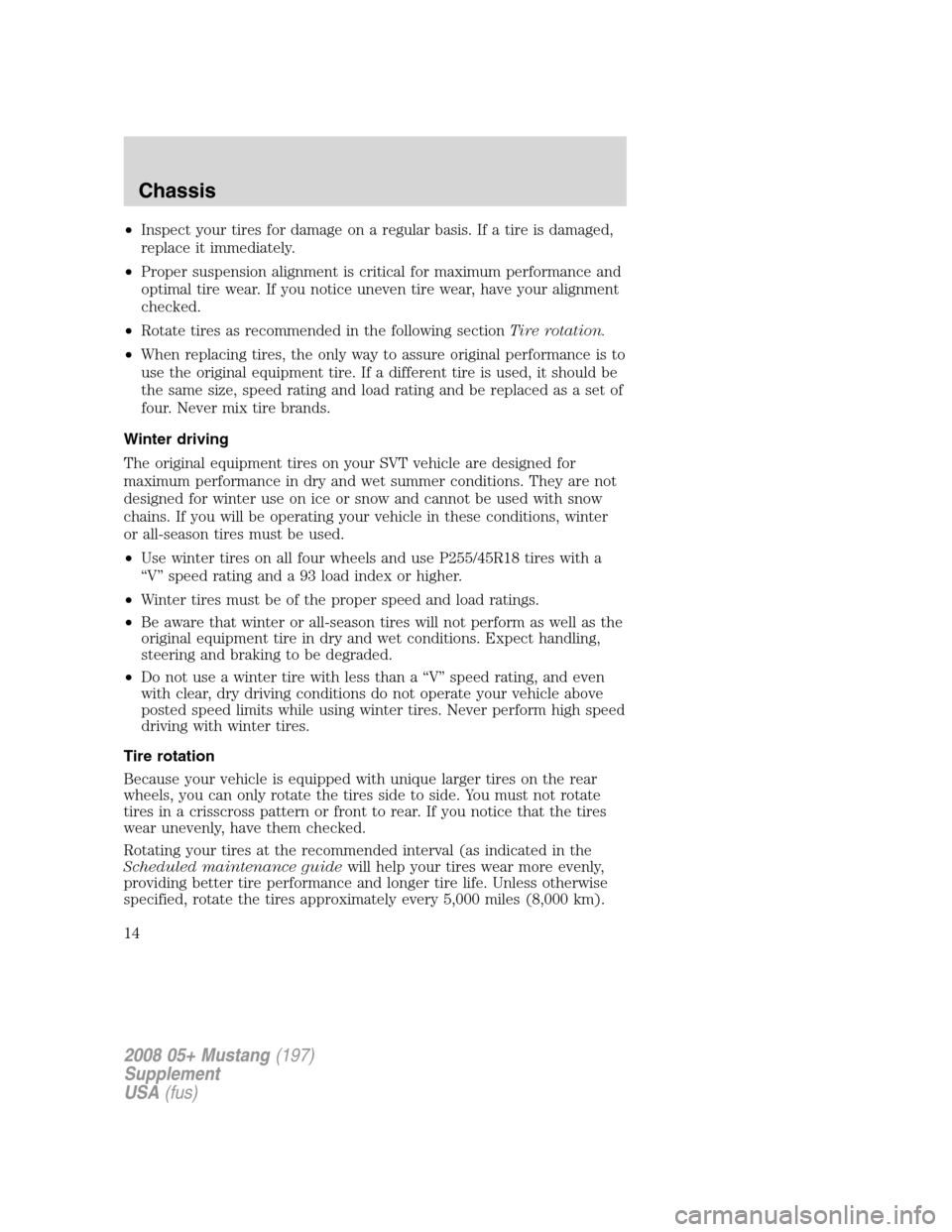
•Inspect your tires for damage on a regular basis. If a tire is damaged,
replace it immediately.
•Proper suspension alignment is critical for maximum performance and
optimal tire wear. If you notice uneven tire wear, have your alignment
checked.
•Rotate tires as recommended in the following sectionTire rotation.
•When replacing tires, the only way to assure original performance is to
use the original equipment tire. If a different tire is used, it should be
the same size, speed rating and load rating and be replaced as a set of
four. Never mix tire brands.
Winter driving
The original equipment tires on your SVT vehicle are designed for
maximum performance in dry and wet summer conditions. They are not
designed for winter use on ice or snow and cannot be used with snow
chains. If you will be operating your vehicle in these conditions, winter
or all-season tires must be used.
•Use winter tires on all four wheels and use P255/45R18 tires with a
“V” speed rating and a 93 load index or higher.
•Winter tires must be of the proper speed and load ratings.
•Be aware that winter or all-season tires will not perform as well as the
original equipment tire in dry and wet conditions. Expect handling,
steering and braking to be degraded.
•Do not use a winter tire with less than a “V” speed rating, and even
with clear, dry driving conditions do not operate your vehicle above
posted speed limits while using winter tires. Never perform high speed
driving with winter tires.
Tire rotation
Because your vehicle is equipped with unique larger tires on the rear
wheels, you can only rotate the tires side to side. You must not rotate
tires in a crisscross pattern or front to rear. If you notice that the tires
wear unevenly, have them checked.
Rotating your tires at the recommended interval (as indicated in the
Scheduled maintenance guidewill help your tires wear more evenly,
providing better tire performance and longer tire life. Unless otherwise
specified, rotate the tires approximately every 5,000 miles (8,000 km).
2008 05+ Mustang(197)
Supplement
USA(fus)
Chassis
14
Page 15 of 40
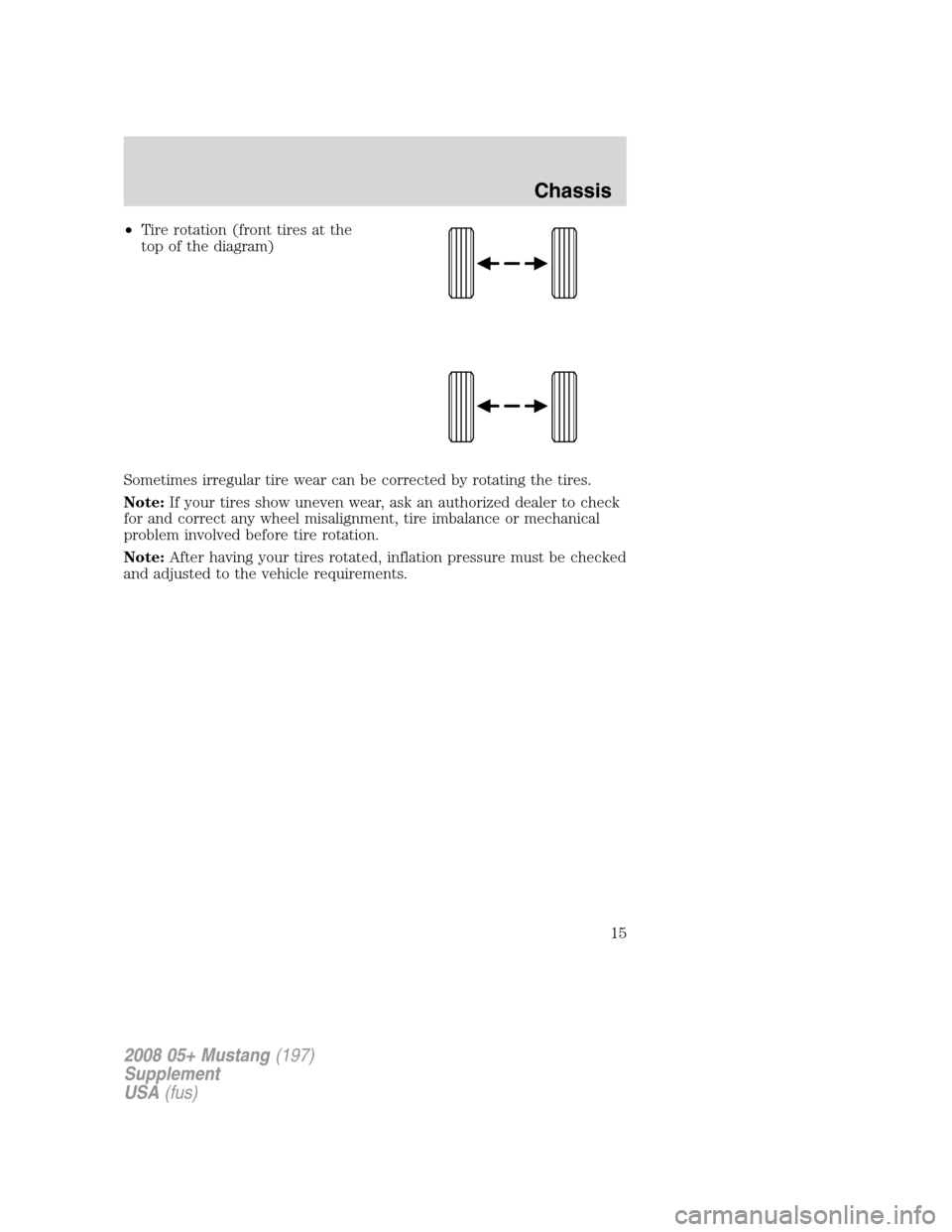
•Tire rotation (front tires at the
top of the diagram)
Sometimes irregular tire wear can be corrected by rotating the tires.
Note:If your tires show uneven wear, ask an authorized dealer to check
for and correct any wheel misalignment, tire imbalance or mechanical
problem involved before tire rotation.
Note:After having your tires rotated, inflation pressure must be checked
and adjusted to the vehicle requirements.
2008 05+ Mustang(197)
Supplement
USA(fus)
Chassis
15
Page 16 of 40
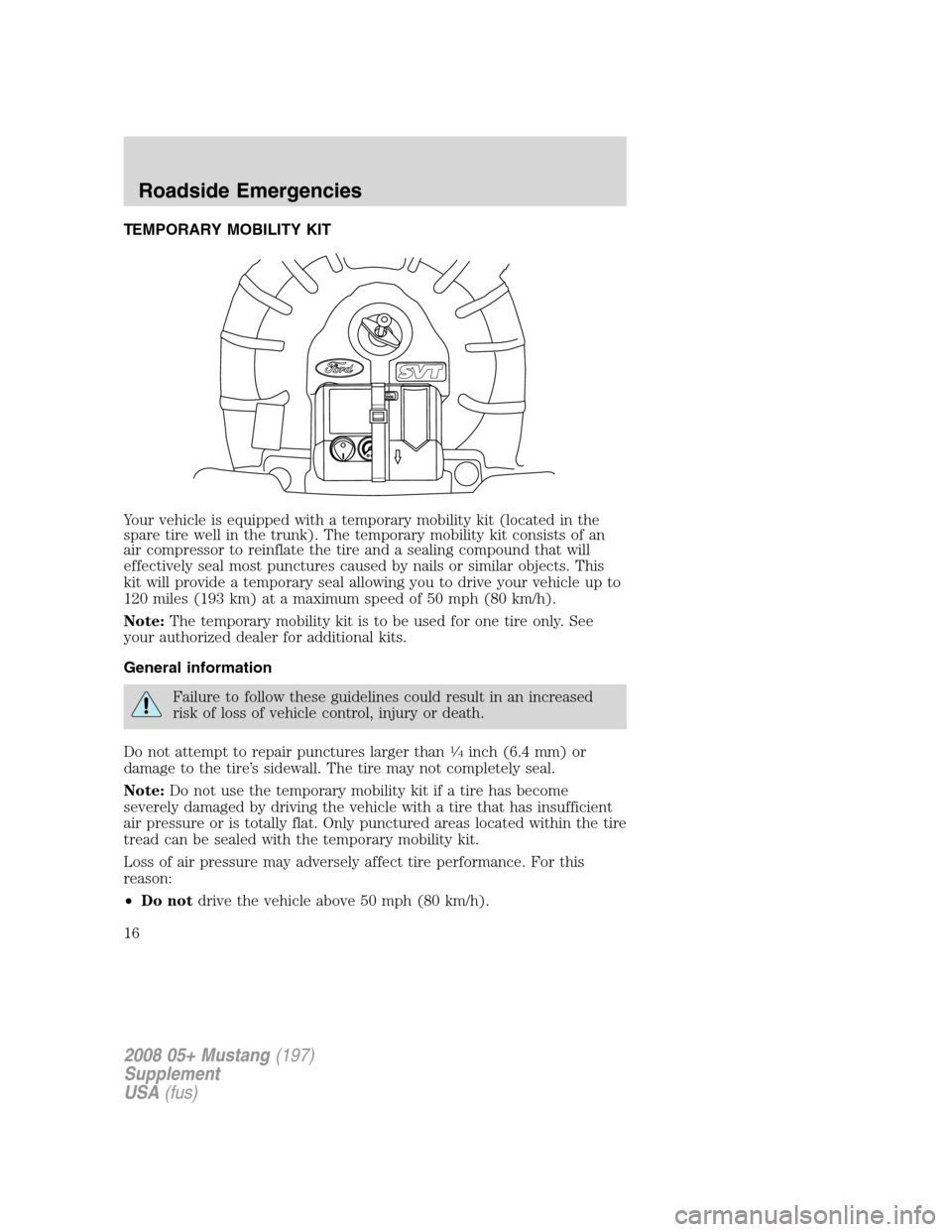
TEMPORARY MOBILITY KIT
Your vehicle is equipped with a temporary mobility kit (located in the
spare tire well in the trunk). The temporary mobility kit consists of an
air compressor to reinflate the tire and a sealing compound that will
effectively seal most punctures caused by nails or similar objects. This
kit will provide a temporary seal allowing you to drive your vehicle up to
120 miles (193 km) at a maximum speed of 50 mph (80 km/h).
Note:The temporary mobility kit is to be used for one tire only. See
your authorized dealer for additional kits.
General information
Failure to follow these guidelines could result in an increased
risk of loss of vehicle control, injury or death.
Do not attempt to repair punctures larger than
1�4inch (6.4 mm) or
damage to the tire’s sidewall. The tire may not completely seal.
Note:Do not use the temporary mobility kit if a tire has become
severely damaged by driving the vehicle with a tire that has insufficient
air pressure or is totally flat. Only punctured areas located within the tire
tread can be sealed with the temporary mobility kit.
Loss of air pressure may adversely affect tire performance. For this
reason:
•Do notdrive the vehicle above 50 mph (80 km/h).
2008 05+ Mustang(197)
Supplement
USA(fus)
Roadside Emergencies
16
Page 17 of 40
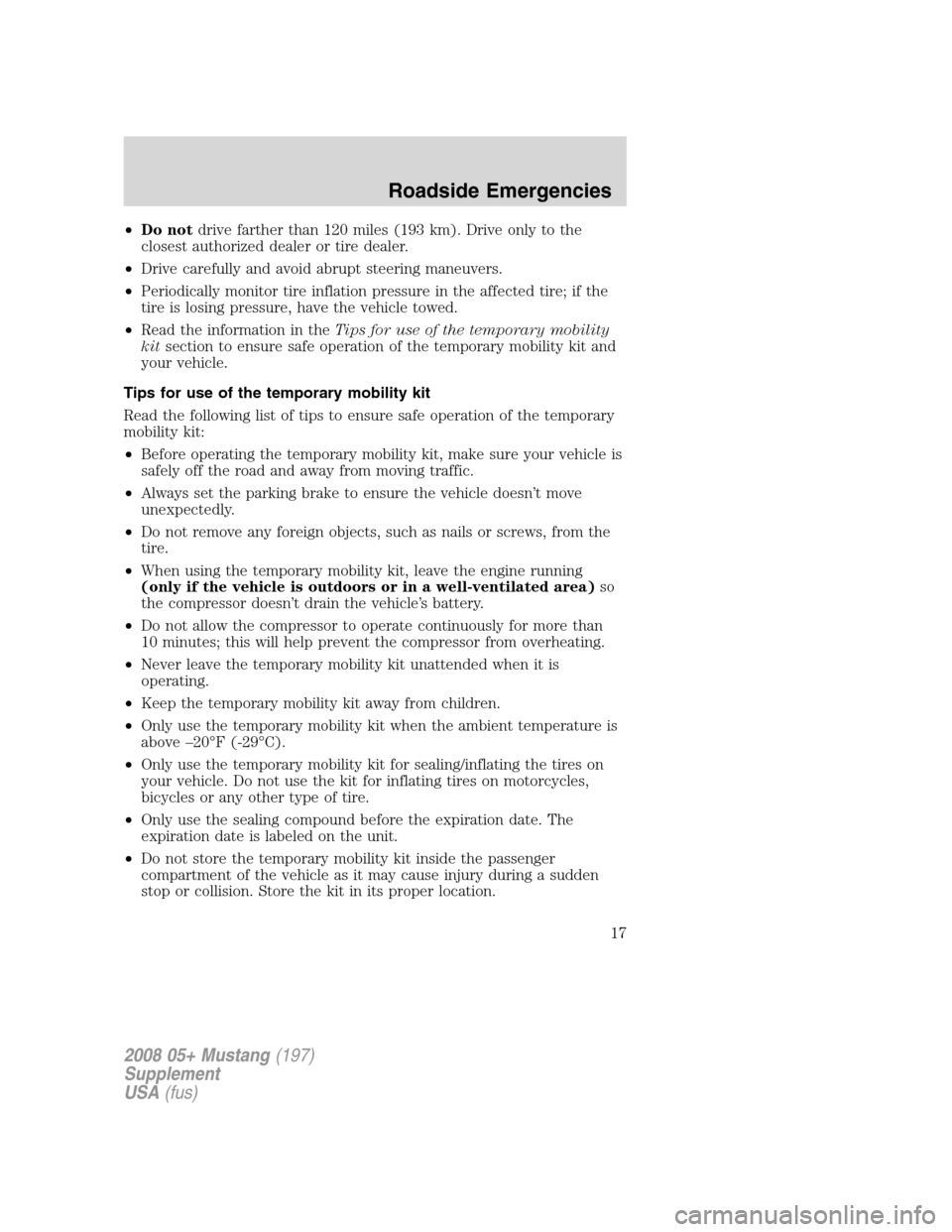
•Do notdrive farther than 120 miles (193 km). Drive only to the
closest authorized dealer or tire dealer.
•Drive carefully and avoid abrupt steering maneuvers.
•Periodically monitor tire inflation pressure in the affected tire; if the
tire is losing pressure, have the vehicle towed.
•Read the information in theTips for use of the temporary mobility
kitsection to ensure safe operation of the temporary mobility kit and
your vehicle.
Tips for use of the temporary mobility kit
Read the following list of tips to ensure safe operation of the temporary
mobility kit:
•Before operating the temporary mobility kit, make sure your vehicle is
safely off the road and away from moving traffic.
•Always set the parking brake to ensure the vehicle doesn’t move
unexpectedly.
•Do not remove any foreign objects, such as nails or screws, from the
tire.
•When using the temporary mobility kit, leave the engine running
(only if the vehicle is outdoors or in a well-ventilated area)so
the compressor doesn’t drain the vehicle’s battery.
•Do not allow the compressor to operate continuously for more than
10 minutes; this will help prevent the compressor from overheating.
•Never leave the temporary mobility kit unattended when it is
operating.
•Keep the temporary mobility kit away from children.
•Only use the temporary mobility kit when the ambient temperature is
above –20°F (-29°C).
•Only use the temporary mobility kit for sealing/inflating the tires on
your vehicle. Do not use the kit for inflating tires on motorcycles,
bicycles or any other type of tire.
•Only use the sealing compound before the expiration date. The
expiration date is labeled on the unit.
•Do not store the temporary mobility kit inside the passenger
compartment of the vehicle as it may cause injury during a sudden
stop or collision. Store the kit in its proper location.
2008 05+ Mustang(197)
Supplement
USA(fus)
Roadside Emergencies
17
Page 18 of 40
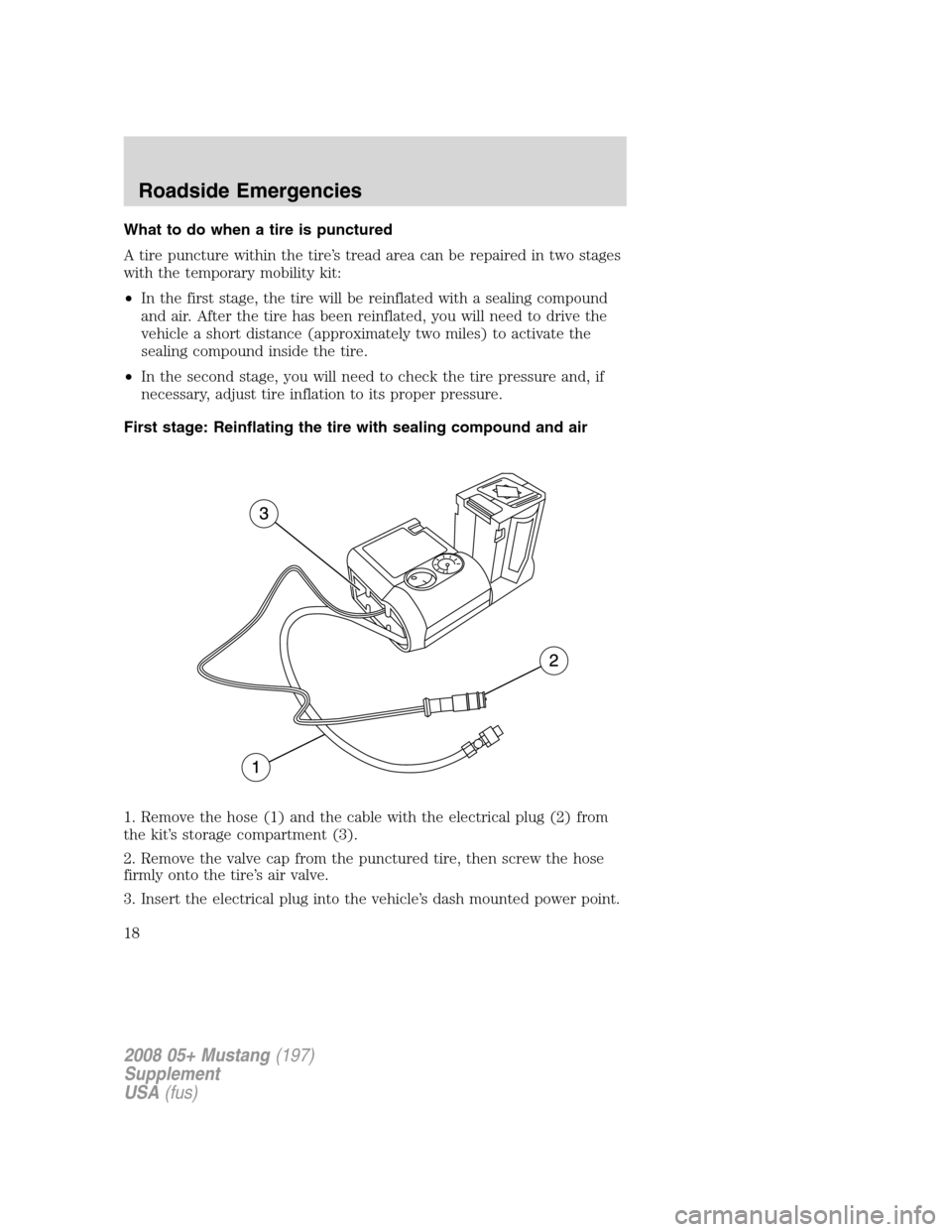
What to do when a tire is punctured
A tire puncture within the tire’s tread area can be repaired in two stages
with the temporary mobility kit:
•In the first stage, the tire will be reinflated with a sealing compound
and air. After the tire has been reinflated, you will need to drive the
vehicle a short distance (approximately two miles) to activate the
sealing compound inside the tire.
•In the second stage, you will need to check the tire pressure and, if
necessary, adjust tire inflation to its proper pressure.
First stage: Reinflating the tire with sealing compound and air
1. Remove the hose (1) and the cable with the electrical plug (2) from
the kit’s storage compartment (3).
2. Remove the valve cap from the punctured tire, then screw the hose
firmly onto the tire’s air valve.
3. Insert the electrical plug into the vehicle’s dash mounted power point.
2008 05+ Mustang(197)
Supplement
USA(fus)
Roadside Emergencies
18
Page 19 of 40
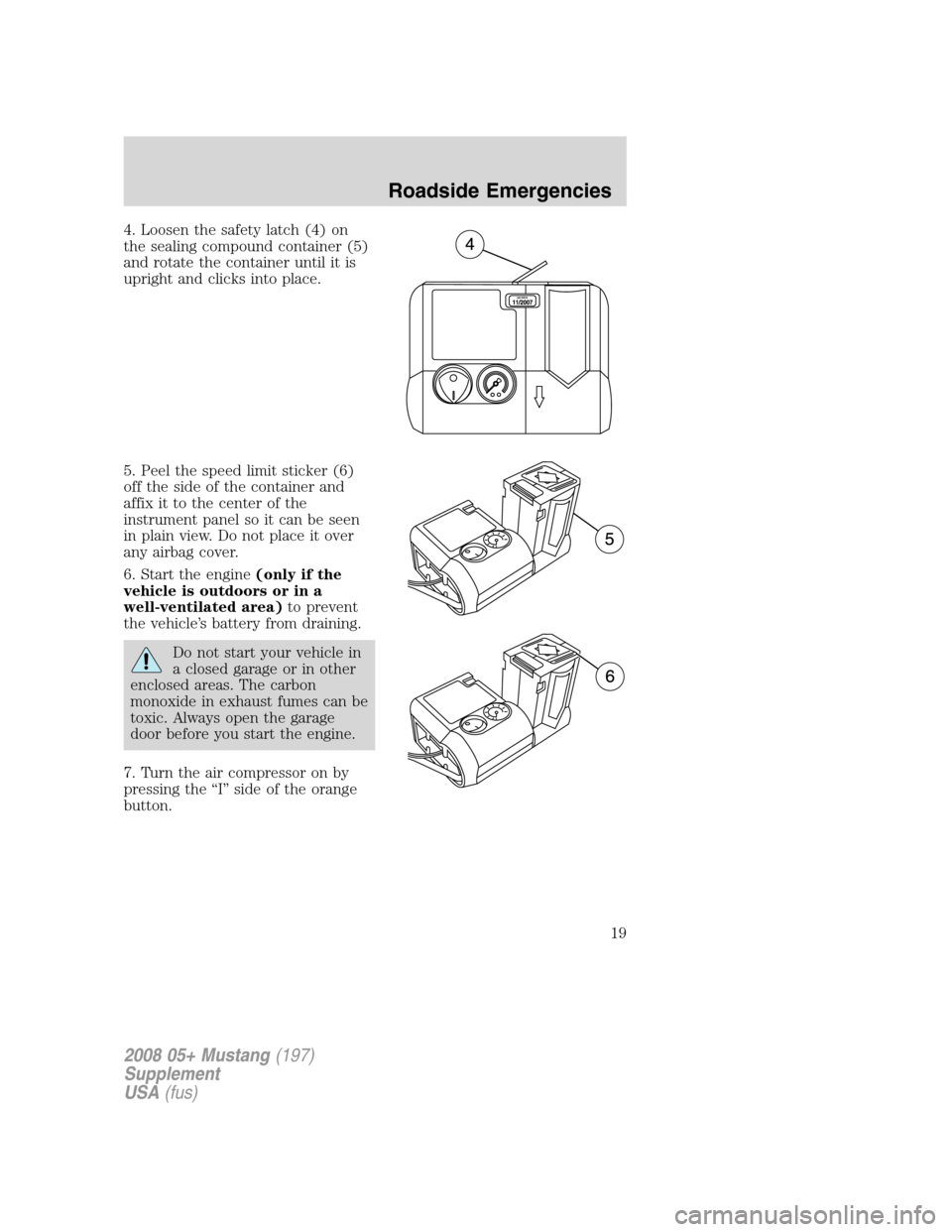
4. Loosen the safety latch (4) on
the sealing compound container (5)
and rotate the container until it is
upright and clicks into place.
5. Peel the speed limit sticker (6)
off the side of the container and
affix it to the center of the
instrument panel so it can be seen
in plain view. Do not place it over
any airbag cover.
6. Start the engine(only if the
vehicle is outdoors or in a
well-ventilated area)to prevent
the vehicle’s battery from draining.
Do not start your vehicle in
a closed garage or in other
enclosed areas. The carbon
monoxide in exhaust fumes can be
toxic. Always open the garage
door before you start the engine.
7. Turn the air compressor on by
pressing the “I” side of the orange
button.
2008 05+ Mustang(197)
Supplement
USA(fus)
Roadside Emergencies
19
Page 20 of 40
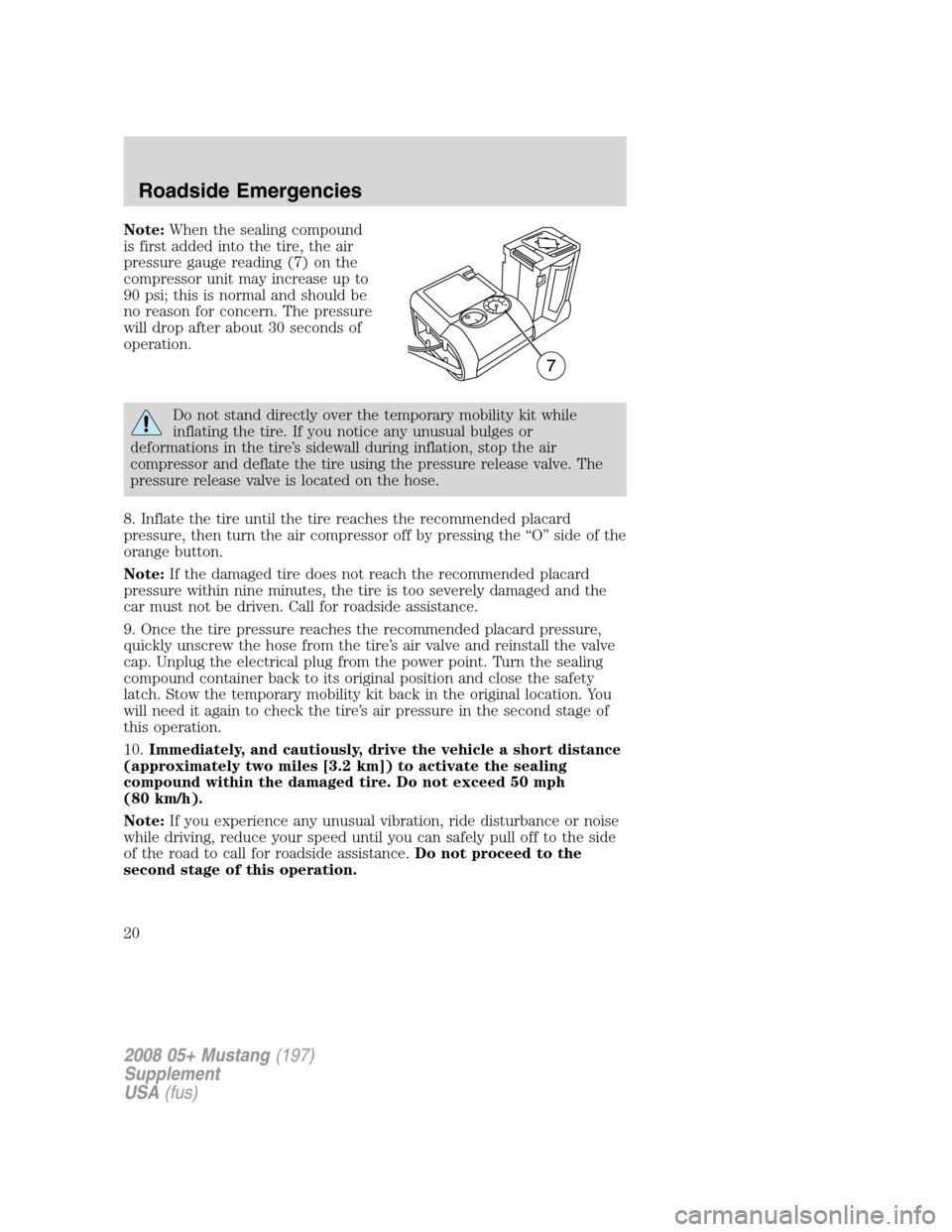
Note:When the sealing compound
is first added into the tire, the air
pressure gauge reading (7) on the
compressor unit may increase up to
90 psi; this is normal and should be
no reason for concern. The pressure
will drop after about 30 seconds of
operation.
Do not stand directly over the temporary mobility kit while
inflating the tire. If you notice any unusual bulges or
deformations in the tire’s sidewall during inflation, stop the air
compressor and deflate the tire using the pressure release valve. The
pressure release valve is located on the hose.
8. Inflate the tire until the tire reaches the recommended placard
pressure, then turn the air compressor off by pressing the “O” side of the
orange button.
Note:If the damaged tire does not reach the recommended placard
pressure within nine minutes, the tire is too severely damaged and the
car must not be driven. Call for roadside assistance.
9. Once the tire pressure reaches the recommended placard pressure,
quickly unscrew the hose from the tire’s air valve and reinstall the valve
cap. Unplug the electrical plug from the power point. Turn the sealing
compound container back to its original position and close the safety
latch. Stow the temporary mobility kit back in the original location. You
will need it again to check the tire’s air pressure in the second stage of
this operation.
10.Immediately, and cautiously, drive the vehicle a short distance
(approximately two miles [3.2 km]) to activate the sealing
compound within the damaged tire. Do not exceed 50 mph
(80 km/h).
Note:If you experience any unusual vibration, ride disturbance or noise
while driving, reduce your speed until you can safely pull off to the side
of the road to call for roadside assistance.Do not proceed to the
second stage of this operation.
2008 05+ Mustang(197)
Supplement
USA(fus)
Roadside Emergencies
20